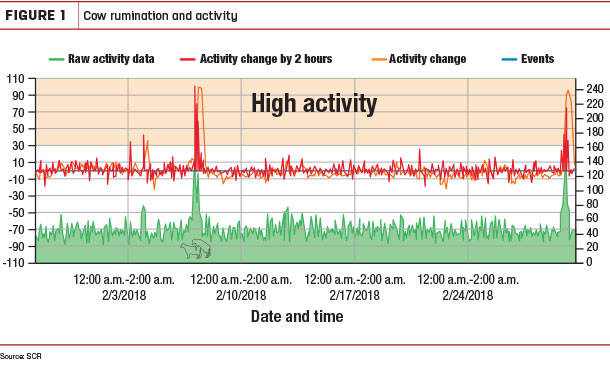Dairies are constantly learning how to put the actionable data from animal monitoring systems to work in new and different ways to benefit their herds. Astute producers use this information to elevate animal productivity and management to new heights while improving cow comfort and health at the same time.
The difference is breaking away from traditional perceptions of managing by averages and shifting toward using individual cow data points to see what each cow is doing at any point during the day; and then interpreting that information to understand – and act on – what the cow is telling you about what it really needs from you.
Revamping reproductive programs
Managing individual cow reproduction is one of the most meaningful changes users of animal monitoring systems have adopted.
Highly accurate heat detection of 95 percent or higher means users can depend on system data to find cows in heat, as well as determine the best timing for breeding and identify those cows requiring extra attention to help achieve reproductive goals.
Plus, rapid data capture means users can view animal rumination and activity in real-time. This ability enhances management effectiveness to help ensure any action taken, or deliberately not taken, is based on what’s happening with the cow and increase odds of success.
For instance, the record in Figure 1 clearly indicates this animal is in estrus and should receive an insemination at the appropriate time.

The noteworthy reliability of this information means dairies are able to make sizable increases in pregnancy rates while reducing reliance on herd-wide synchronization protocols. Note, however, these protocols still serve as treatment tools when interventions are necessary.
Dairies may also use individual cow data to assess the probability a cow is open following insemination. This level of detail allows them to make individual decisions in the best interest of the cow.
The dairy can monitor the cow’s rumination and activity and determine if it should be re-enrolled in the breeding protocol. Or if the data indicate that the cow is on track for the regular herd health exam and is diagnosed pregnant at that time, the dairy can still monitor the cow’s performance until pregnancy is reconfirmed – and beyond if deemed necessary.
If the cow lost the pregnancy prior to a physical exam or other pregnancy diagnosis, the technology gives the dairy the opportunity to make an early judgement and any needed health or management interventions to ensure the cow remains in the herd.
Because of this shift in strategy, farms utilizing animal monitoring systems are often able to restructure management activities, including protocol steps and pregnancy exams, to reduce interactions – or touches – with cows. This reduction in the need for management activities on a per-cow basis reduces inadvertent stress on healthy cows.
Further refining management
Since dairies can depend on animal monitoring data to make reproductive program outcomes more certain, many farms have taken the information a step further.
When integrated with milk production and health data, one of these possibilities is to identify the healthiest, highest performers in the herd as recipients of elite genetics or as donors to in vitro fertilization programs to enhance genetic progress.
One strategy would be to breed the top 10 percent of your best-performing, healthiest cows to high-ranking sires based on your selection criteria and herd goals.
Conversely, these data can also be used to help identify those animals that would best serve as in vitro fertilization recipients, those that may require other reproductive interventions – including anovular cows – or those requiring re-enrollment in reproductive protocols. Or identifying animals ready for a career change.
In addition, dairies are looking more closely at average weekly yields and lactation status by days in milk. Individual cows can get lost in the averages. Don’t lose sight of individual cow needs and performance.
The information can also be used to alter voluntary waiting periods for highly productive animals. This enables producers to manage the “groups within groups” to provide individualized attention and optimize animal productivity.
Again, because of the ability to get cows pregnant due to enhanced heat detection, dairies have found they can be more flexible with reproductive programs. They don’t have to be tightly focused on creating pregnancies as soon as possible in early lactation.
For example, one dairy increased its pregnancy rate from 15 to 25 percent after the installation of an animal monitoring system and relaxing its 60-day voluntary waiting period. This change allowed cows to produce more milk at the most profitable times of their lactation. In addition, the reduced human interaction enabled the cows to spend more time on desired behaviors including eating and lying – two essential components of productivity and well-being.
Ultimately, the actionable data from animal monitoring provided the dairy with an accurate assessment of cow status, allowing more freedom in conducting reproductive programs. ![]()
Steve Pavelski is the Northeast sales manager for SCR Dairy Inc. Email Steve Pavelski.






